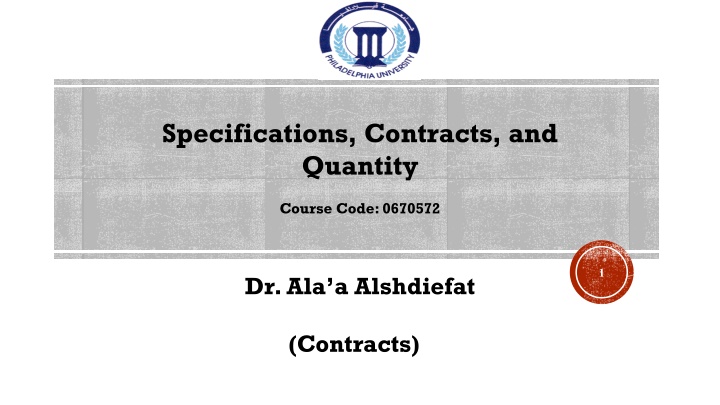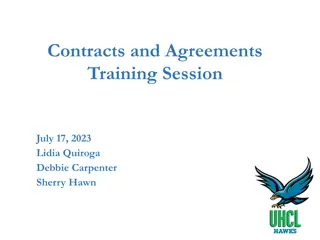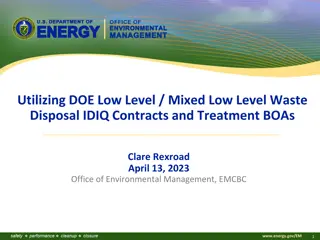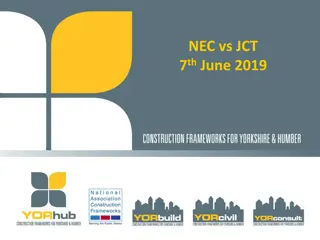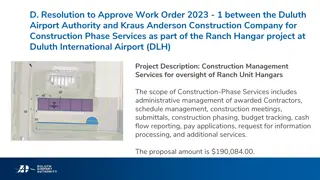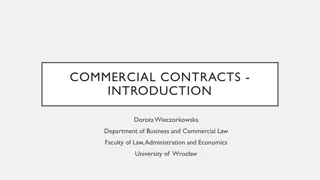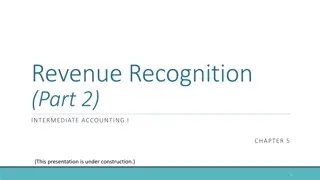Importance of Construction Contracts in Construction Projects
The construction phase plays a crucial role in the success of a project, with a significant portion of the budget being allocated during this stage. Quality workmanship, proper contract documents, skilled laborers, and effective management are key factors influencing the outcome. Construction contracts serve as a legal framework, outlining agreements, responsibilities, and protection for all parties involved, ensuring projects are completed within budget and schedule.
Download Presentation

Please find below an Image/Link to download the presentation.
The content on the website is provided AS IS for your information and personal use only. It may not be sold, licensed, or shared on other websites without obtaining consent from the author.If you encounter any issues during the download, it is possible that the publisher has removed the file from their server.
You are allowed to download the files provided on this website for personal or commercial use, subject to the condition that they are used lawfully. All files are the property of their respective owners.
The content on the website is provided AS IS for your information and personal use only. It may not be sold, licensed, or shared on other websites without obtaining consent from the author.
E N D
Presentation Transcript
Specifications, Contracts, and Quantity Course Code: 0670572 1 Dr. Ala a Alshdiefat (Contracts)
Importance of Construction The construction phase is important because the quality of the completed project is highly dependent on the workmanship and management of construction. The construction phase is also important because a majority of the total project budget and schedule is expended during construction. The quality of construction depends on; 1. The completeness and quality of the contract documents that are prepared by the designer 2. Laborers who have the skills necessary to produce the work, 3. Field supervisors who have the ability to coordinate the numerous activities that are required to construct the project in the field 4. The quality of materials that are used for construction of the project. Dr. Ala'a Alshdiefat 2
Importance of Construction The design costs for a project generally range from 7% to 12%. Using a10% medium value, then 90% of the cost of a project is expended during construction. Thus, a 15% variation in design costs may impact the project by only 1.5%, whereas a 15% variation in construction costs may impact the project by 13.5%. Dr. Ala'a Alshdiefat 3
Assumptions for Construction Phase The objective during the construction phase is to build the project in accordance with the plans and specifications, within budget and on schedule. To achieve this objective there are three assumptions as shown in Table. Dr. Ala'a Alshdiefat 4
The Structure of Responsibilities in Construction Projects Dr. Ala'a Alshdiefat 5
Contract Definition Contract definition - "an agreement between two or more parties which is intended to have legal consequences". The construction contract is considered as an agreement between two or more parties in which an offers are made and accepted to get a benefit for each part. The agreement can be informal or formal, oral or written. The contract documents are the framework of the working relationship between all parties of the project. According to FIDIC, contract means the general conditions, the supplementary conditions, the specifications, the drawings, the bill of quantities, the tender, the letter of acceptance, the contract agreement, and such further documents as may be expressly incorporated in the letter of acceptance or contract agreement. Dr. Ala'a Alshdiefat 6
Contract Definition Construction contracts allow for the legal protection of all parties involved in the contract. According to method of payment, contract is the agreement about how owner will pay the contractor for work performed (Abd Elshakour,2010) Dr. Ala'a Alshdiefat 7
Contract Aim The contractual aim is to achieve: 1. Quality of the built environment 2. Sustainable and sensitive land use 3. Inspired, sympathetic and aesthetically appealing architecture 4. Affordable, functionally well-designed and well-constructed domestic, commercial and industrial buildings, facilities and infrastructure 5. High standards of inbuilt utility/health and safety/energy efficiency/maintainability/environment- friendly features. Dr. Ala'a Alshdiefat 8
Contract Rules A contract does not have to be written or in any special form but to make a contract valid and legally enforceable, the following rules are applied: 1. There must be an offer by one party and an acceptance by the other or others 2. A client is responsible for making payments and the parties in the contract must deliver the services and the construction (building or infrastructure). 3. Each party must have the legal capacity to make a contract. 4. The parties must have exercised their own free will, without force or pressure. Dr. Ala'a Alshdiefat 9
Contract Documents The contract comprises of a variety of documents such as: 1. Contract drawings 2. Specification 3. Bill of quantities (where appropriate) 4. General conditions of contract (responsibilities, obligations and liabilities of the parties, payment, extensions of time, alterations, disputes, adjudication, etc) 5. Special conditions 6. The tender that is the financial offer submitted by the parties to carry out the work 7. The legal agreement or contract 8. Invitation (if it contains data on completion dates or other information that is not repeated in the contract) 9. Addenda (if any) Dr. Ala'a Alshdiefat 10
Factors of Selection Construction Contracts There are many types of contracts that are used in construction industries; choices of these contracts are vary from project to another. Construction contracts must be selected after careful analysis of the situation of the project and put factors that influent on the project into consideration, and these factors are: 1- The project Nature. 2- Project complexity and uniqueness. 3- The Scope of project 4- The Project Duration (start and completion time). 5- Total cost of project. 6- Accountability and Ability of owner to manage design and construction. 7- To provide a good motivation for efficient performance by the contractor. 8- The flexibility and probability to make changes during construction. 9- The market place factors (Local and international). 10- Financial situation and condition for owner. Dr. Ala'a Alshdiefat 11
Project Delivery (Project Procurement) Design/Bid/Build Design/Bid/Build Method of Project Delivery Design/bid/build is often considered the traditional project delivery method. All design work is completed before starting the bid and construction process. This delivery method is usually selected for projects when cost is primary,schedule is secondary,and the scope is well defined. The (DBB) project delivery method is a three-party arrangement involving the owner, designer, and contractor. The owner signs one contract with the designer for design services and signs another contract with the contractor for construction services. Both the designer and contractor work for the owner. In DBB the responsibility, risk, and involvement of all parties are well defined. The owner has a relatively high level of involvement and control during design, but low involvement during construction because the contract documents clearly define what the contractor must do. Dr. Ala'a Alshdiefat 12
Project Delivery (Project Procurement) Design/Bid/Build Project Organization Structure of DBB (Aasrum, 2016) Dr. Ala'a Alshdiefat 13
Project Delivery (Project Procurement) Design/Bid/Build Advantage of Design/Bid/Build Method of Project Delivery (Aasrum, 2016) Dr. Ala'a Alshdiefat 14
Project Delivery (Project Procurement) Design/Bid/Build It is during the construction phase that a majority of the problems associated with the Design-Bid- Build project process materialize. Errors and omissions by the design team are identified, unanticipated site conditions can cause changes to the design, and new requirements by the owner can arise. All changes deviating from the original design intent thus lead to monetary costs, time delays,and increased tension among the project team. Dr. Ala'a Alshdiefat 15
Project Delivery (Project Procurement) Design/Build The D/B method of project delivery is a two-party arrangement, involving the owner and the D/B Company. A contract is signed between the owner and the D/B firm to perform both design and construction services. All design, including construction drawings, are done by the DB contractor. All construction is done by the D/B contractor, although the D/B contractor may hire one or many subcontractors. The design/build (DB) project delivery method is often chosen to compress the time to complete the project.The completion time usually is reduced because construction can start before all the design is completed. The owner has considerable control and level of involvement throughout the project. This provides flexibility to the owner for revision of the design during construction. The D/B project delivery method is usually selected for projects when the schedule is primary, the cost is secondary,and the scope is not well defined. Dr. Ala'a Alshdiefat 16
Project Delivery (Project Procurement) Design/Build It is common to choose the D/B firm by a qualifications-based selection (QBS) procedure. The owner solicits proposals from a prequalified or prescreened list of firms. An evaluation process is used to assess quality, safety record, schedule, cost performance on past jobs, and other factors from each prospective D/B firm.Thus,selection is based on qualification rather than price. Project Organization Structure of DB (Aasrum, 2016) Dr. Ala'a Alshdiefat 17
Project Delivery (Project Procurement) Design/Build The cost of the D/B services is usually based on some type of cost-reimbursable arrangement, either cost plus a fixed amount or cost plus a percentage. Handling inspection is an issue that must be addressed early in the project, because the designer is also the builder. If qualified individuals are available in the owner's organization, the owner may perform inspection.In some situations,an independent third party is used for inspection services. Dr. Ala'a Alshdiefat 18
Project Delivery Design/Build Advantages and Disadvantages of Design/Build Delivery Method (Aasrum, 2016) Dr. Ala'a Alshdiefat 19
Project Delivery Construction Management Method The CM is a firm outside the owner's organization that acts as the agent for the owner. The CM firm perform no design or construction but assists the owner in selecting one or more design firms and one or more construction contractors to build the project. The CM firm assumes no risks because all contracts are signed between the owner and the designers and/or contractors. The design and construction is performed by firms outside the owner's organization with the corporate CM staff managing and coordinating overall effort. Dr. Ala'a Alshdiefat 20
Project Delivery Construction Management Method Project Organization Structure for CM at Risk (Aasrum, 2016) Dr. Ala'a Alshdiefat 21
Project Delivery Construction Management Method Advantages and Disadvantages of CM at Risk (Aasrum, 2016) Dr. Ala'a Alshdiefat 22
Project Delivery Fast-Track Projects Fast-track is the term commonly used for projects that must be completed in the earliest possible time. Construction work overlaps design.As soon as a portion of the design is completed,then construction work is started. Fast-track projects can be performed under the D/B or CM methods of project delivery. Fast-track applies to projects that are schedule driven at the request of the owner. For example, the owner may want to complete a process plant at the earliest possible date in order to produce and market a product before a competitor. Dr. Ala'a Alshdiefat 23
Project Delivery Turn-Key Projects Turn-key is the term commonly used for projects that are designed, built, and put into operation before the project is turned over to the owner. The company providing the turn-key services may secure the land for the project, perform or coordinate all aspects of the design, arrange and administer construction contracts, manage construction of the project, staff and train the personnel to operate the facility, and then turn the project over to the owner. Turn-key projects typically are manufacturing or process plant type facilities in remote locations. Dr. Ala'a Alshdiefat 24
Project Delivery Integrated Project Delivery (IPD) Method Integrated Project Delivery (IPD) is a project delivery approach that integrates people, systems, business structures and practices into a process that collaboratively harnesses the talents and insights of all participants to optimize project results, increase value to the owner, reduce waste, and maximize efficiency through all phases of design, fabrication, and construction. Integrated projects are uniquely distinguished by highly effective collaboration among the owner, the prime designer, and the prime constructor, commencing at early design and continuing through to project handover (The American Institute of Architects, 2007). The main advantage of IPD for owners; early and open sharing of project knowledge streamlines project communications and allows owners to effectively balance project options to meet their business enterprise goals. Dr. Ala'a Alshdiefat 25
Project Delivery Integrated Project Delivery (IPD) Method Integrated delivery strengthens the project teams understanding of the owners desired outcomes, thus improving the teams ability to control costs and manage the budget, all of which increase the likelihood that project goals, including schedule, life cycle costs, quality and sustainability, will be achieved. It is also important to understand that spending more during design and planning and use of integrated delivery techniques can substantially reduce construction process costs, change orders and requests for information. But IPD can be challenging because it is new and completely different than the traditional way the industry has been doing business. IPD requires greater collaboration resulting in new technologies, new software, equipment, and training all combined with IPD s expectations. Dr. Ala'a Alshdiefat 26
Project Delivery Integrated Project Delivery (IPD) Method Other issues arise when contactors and sub-contractors are asked to revise their construction management and processes to more fully execute integrated project delivery. For example, contractors may not have the mechanisms in place to manage the waste and material documentation that is required of them and therefore incorrectly estimate the cost and perceived hassle of implementing these measures into their processes, (The American Institute of Architects, 2007). Dr. Ala'a Alshdiefat 27
Types of Construction Contract Constructions contract divided into several categories. The main two construction contracts are; 1. Fixed Price Contract 2. Cost Reimbursement Contract Under each of them; there are a broad types of contracts Dr. Ala'a Alshdiefat 28
Types of Construction Contract - Fixed Price Contract Fixed price contract put responsibility for delivery of construction project with full performance and meet specification on contractor at a price which is subjected to contractually specified adjustment. Fixed price contract can be: 1. Lump Sum Contract 2. Unit Price Contract (Bill of Quantity Contract) Dr. Ala'a Alshdiefat 29
Types of Construction Contract - Fixed Price Contract Lump Sum Contract In Lump Sum Contract or Single Fixed Price contract, the contractor agreed to perform specific amount of work for a fixes sum of money,also it considered as a single tender price for the completion of a specific work to meet owner's requirement by a certain date. Lump sum contract need a fully developed plan and specification, and the work should be accurately and completely defined at time of bidding with limit variation. The price in lump sum contract includes everything necessary for carrying out the work as well as the payment should be divided on time intervals related to completion of milestone. Dr. Ala'a Alshdiefat 30
Types of Construction Contract - Fixed Price Contract Lump Sum Contract The main advantages of Lump Sum Contract are; 1- The owner knows the total price before work start. 2- The contractor can be used any method to perform the works. 3- The contractor has more incentive to increase the profit and reducing the cost. 4- Low financial risk to the owner,while high financial risk to the contractor. Dr. Ala'a Alshdiefat 31
Types of Construction Contract - Fixed Price Contract Lump Sum Contract The main disadvantages of Lump Sum Contract are; 1- The contractor has a lot quantity of works in preparing the estimate which is wasteful of skilled estimator time. 2- The contract is very limited flexibility for design changes and costly in case it happened. 3- High percent of risk lie on contractor. 4- Bidding expensive and required long time. 5- Achieve minimum contract requirements in case the contractor chooses lowest cost, means, method and material. Dr. Ala'a Alshdiefat 32
Types of Construction Contract - Fixed Price Contract Unit Price Contract In unit price contract, the owner and contractor agree to the price that will be paid per unit of major element of the project that is performed by contractor. The owner and engineer specify the work items with estimated quantity in BOQ, that have well defined by professional and experiences but it cannot be accurately determined in advance of construction. The payment is made with depend on unit of work actually performed multiply by the unit prices. On the other hand, contractor overhead, profit and other project expenses must be included in the unit price. Dr. Ala'a Alshdiefat 33
Types of Construction Contract - Fixed Price Contract Unit Price Contract The unit price contract can be bidden in balance or unbalance form, where in balance, each bid is priced to carry its share of the cost of the work and contractor profit, but in unbalance bid the contractor raise prices on certain item and make corresponding reduction of the prices on other items without changing the total amount of the bid. The main advantages of Unit Price Contract are; 1- Saving time and cost of preparing BOQ by contractor. 2- Flexibility for changing. 3- Bidding is easy and competitive. 4- Typical drawings can be used in bidding. 5- The owner has easy way to select contractor. Dr. Ala'a Alshdiefat 34
Types of Construction Contract - Fixed Price Contract Unit Price Contract The main disadvantages of Unit Price Contract are; 1- Final cost of the project is not known until the completion of the project. 2- More site staff needed to measure,control and report on unit completed. 3- Unbalance bidding may be used. Dr. Ala'a Alshdiefat 35
Types of Construction Contract - Cost Reimbursable Contract In this type of contract, the contractor is reimbursed for actual cost of material, labor, and construct, plus charge to cover overheads and profit. Charge can be fixed sum or percentages. Cost reimbursable contracts are preferred when the work is unknown, cannot be designed pretender and has high risk option to owner. It is suitable for maintenance and repair works, in emergency conditions, when the owner requirement is vague and desire to start construction concurrently with design. Owner and Engineer should prepare a schedule of the work items without quantity. The description of these items and their unit measurement are similar to that used in BOQ but without quantities. Dr. Ala'a Alshdiefat 36
Types of Construction Contract - Cost Reimbursable Contract The contractor must keep all records and account for supply it to owner, and however he can start works without a clearly defined project scope. The main advantages of this type of contract are the contractor can start works earlier before BOQ full prepared and the owner has more flexibility to make changes. The main disadvantages are; 1. Difficulty to select contractor and determined which offer has most advantages, 2. There is no indication for total cost of project, 3. Financial problems can be occurred for public owner, 4. Contractor may be not careful for cost control. Dr. Ala'a Alshdiefat 37
Types of Construction Contract - Cost Reimbursable Contract Cost reimbursable contract divided into some types based on the charges form such as; 1. Cost plus Percent of Cost Contract 2. Cost plus Fixed Fee Contract 3. Guaranteed Maximum Price Contract (Cost Fixed Fee + Profit Sharing Clause) 4. Target Cost with Variable Fees Contract Dr. Ala'a Alshdiefat 38
Types of Construction Contract - Cost Reimbursable Contract Cost plus Percent of Cost Contract The contractor is reimbursed for total costs with a fixed percent that cover his profit and overheads. The main advantages of cost plus percent of cost contract are; 1- The contractor can be start construction before complete design. 2- The contractor is efficient in the operation and utilization of resources then the total cost can be faired to owner. 3- Low risk to contractor. Dr. Ala'a Alshdiefat 39
Types of Construction Contract - Cost Reimbursable Contract Cost plus Percent of Cost Contract The main disadvantages of cost plus percent of cost contract are; 1- Total cost of project is unknown till project completion. 2- The contractor has not motivated to be efficient in his labor, material, and equipment and to finish construction quickly. 3- Minimum efficiency with maximum profit. 4- Owner must be exercise tight cost control. Dr. Ala'a Alshdiefat 40
Types of Construction Contract - Cost Reimbursable Contract Cost plus Fixed Fee Contract The owner pays to contractor total costs of construction with a fixed sum of money. The main Advantages of cost plus fixed fee contract are; 1- The contractor has not motivation to inflate costs. 2- The contractor has incentive to complete the work quickly for reducing his overheads. The main disadvantages of cost plus fixed fee contract are; 1- Major changes and variation lead to disputes and the fee must be renegotiated. 2- The speed of work is undetermined before a fee can be agreed a fairly detailed description of work that to be made. Dr. Ala'a Alshdiefat 41
Types of Construction Contract - Cost Reimbursable Contract Guaranteed Maximum Price Contract (Cost Fixed Fee + Profit Sharing Clause) The contractor guarantees to construct the project with fully meeting for specification and drawings, while the price will not exceed some total price, and the owner is sharing contractor in profit which consider the percentage of cost under guaranteed maximum price(GMP). The advantage of GMP contract is a motivation that provided for contractor to reduce cost of project. The disadvantage is that the fully plans and specification must be provided with detailed and the contractor is responsible for cost that exceed GMP. Dr. Ala'a Alshdiefat 42
Types of Construction Contract - Cost Reimbursable Contract Target Cost with Variable Fees Contract The owner and contractor must be agreed to the target estimate of construction in target cost with variable fees contract, while the works had a fairly definite nature, drawings and specification to determine accurate cost, however the contractor may be shared in saving or arrangement tied of penalty based on target, in addition there is a fixed sum of money for each day as a time target. The main advantages of target cost with variable fees contract are; 1- The contractor has incentive to finish work early with minimum cost. 2- The owner stands to benefit through the contractor efficiency. the disadvantages of target cost with variable fees contract are; 1- A tied cost control must be exercised. 2- In major changes, variation or cost inflation there some major difficulties may be appear in agreeing on a revised target cost. Dr. Ala'a Alshdiefat 43
Types of Construction Contract Build Own Operate Transfer (BOOT) / Public Private Project (PPP) The basic structure of a BOOT or PPP project is that the Contractor agrees with the client not only to build the project but to arrange finance for the project, and then, using that finance, to build the project, to own the project for a limited period, to operate the project throughout that period, and then, at the end of that period, to transfer the project to the client. This style of structure is employed on public infrastructure projects Dr. Ala'a Alshdiefat 44
Types of Construction Contract Build Own Operate Transfer (BOOT) / Public Private Project (PPP) There are a number of major parties to any BOOT or PPP project, all of whom have particular reasons to be involved in the project. The contractual arrangements between those parties, and the allocation of risks, can be complex. The major parties to a BOOT project will usually include: 1. Government Agency The government agency (usually a government department or statutory authority) will typically: A. Grant to the sponsor the "concession" to build, own and operate the project B. Grant a long term lease of, or sell, the site to the sponsor C. Often acquire most or all of the service provided by the project Dr. Ala'a Alshdiefat 45
Types of Construction Contract Build Own Operate Transfer (BOOT) / Public Private Project (PPP) 2. Sponsor/Proponent The sponsor will typically: A. Procure the concession from the government agency B. Raise equity finance for the project C. Raise debt finance for the project D. Enter into a design and construction contract with the design and construction contractor to design and construct the project E. Enter into an operation and maintenance contract with the operation and maintenance contractor to operate and maintain the project F. Engage consultants for the project G. Enter into a site lease or purchase contract for the site Dr. Ala'a Alshdiefat 46
Types of Construction Contract Build Own Operate Transfer (BOOT) / Public Private Project (PPP) 3. Construction Contractor The construction company may also be one of the sponsors. It will take construction and completion risks, that is, the risk of completing the project on time, within budget and to specifications. 4. Operation and Maintenance Contractor The operator will be expected to sign a long term contract with the sponsor for the operation and maintenance of d the facility. 5. Debt Financiers In a large project there is likely to be a syndicate of banks providing the debt funds to the sponsor. The banks will require a first security over the infrastructure created. The same or different banks will often provide a stand-by loan facility for any cost overruns not covered by the construction contract. Dr. Ala'a Alshdiefat 47
Types of Construction Contract Build Own Operate Transfer (BOOT) / Public Private Project (PPP) 6. Equity Investors It is always necessary to ensure that proposed investors in an infrastructure project have sufficient powers to enter into the relevant contracts and perform their obligations under those contracts. Two examples where powers must be carefully reviewed are life insurance companies and trustees of superannuation funds. 7. Other Parties Other parties such as insurers, equipment suppliers and engineering and design consultants will also be involved. Other parties are involved in an infrastructure project. Dr. Ala'a Alshdiefat 48
